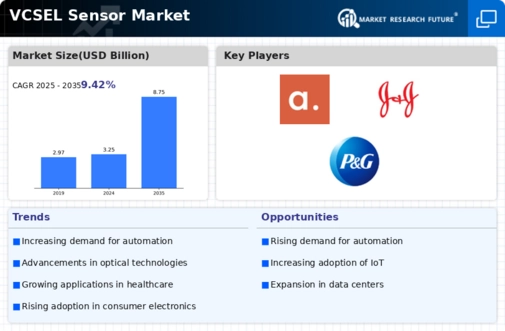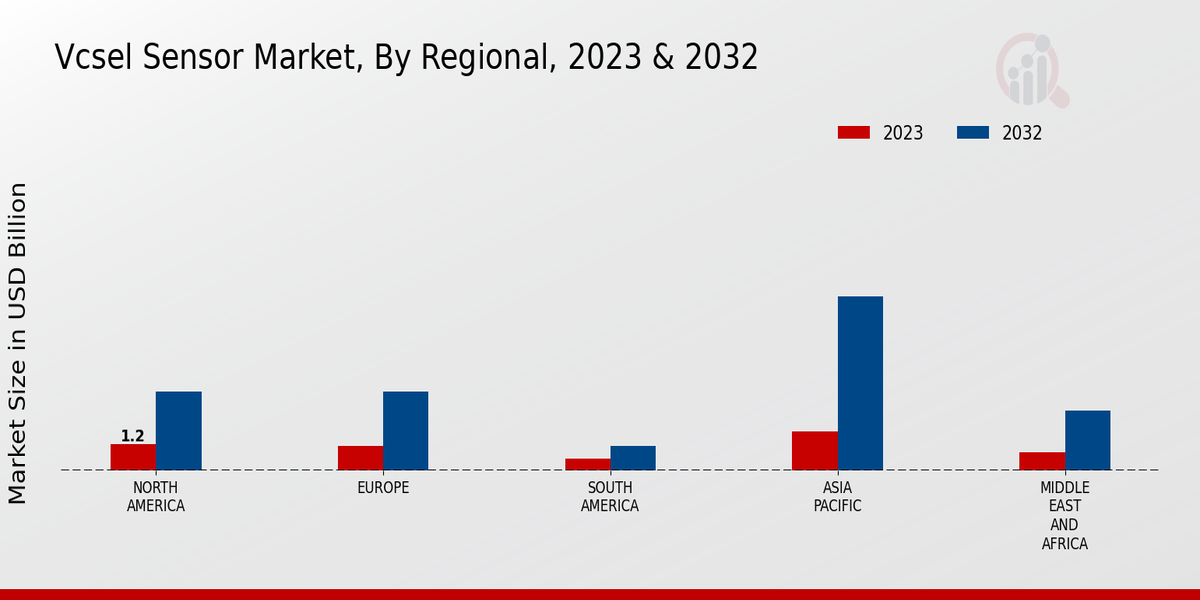Market Growth Projections
The Global VCSEL Sensor Market Industry is projected to experience substantial growth over the coming years. With an estimated market value of 3.25 USD Billion in 2024, the industry is expected to expand significantly, reaching 8.75 USD Billion by 2035. This growth trajectory suggests a compound annual growth rate of 9.42% from 2025 to 2035. Such projections indicate a robust demand for VCSEL sensors across various applications, including consumer electronics, automotive, and industrial automation. The anticipated growth reflects the increasing reliance on advanced sensor technologies in a rapidly evolving technological landscape.
Rising Focus on Energy Efficiency
The Global VCSEL Sensor Market Industry is benefiting from a rising focus on energy efficiency across multiple sectors. VCSEL sensors are known for their low power consumption and high performance, making them an attractive option for energy-conscious applications. As industries and consumers alike prioritize sustainability, the demand for energy-efficient technologies is likely to increase. This shift may propel the market value significantly, as organizations seek to reduce their carbon footprint and operational costs. The emphasis on energy efficiency could drive innovation in VCSEL sensor technology, further enhancing its appeal in the global market.
Emergence of 3D Sensing Technologies
The emergence of 3D sensing technologies significantly impacts the Global VCSEL Sensor Market Industry. VCSEL sensors are integral to 3D sensing applications, which are increasingly utilized in facial recognition, gesture control, and augmented reality. As these technologies gain popularity across various sectors, including gaming and security, the demand for VCSEL sensors is expected to escalate. This trend may lead to a substantial increase in market value, as companies invest in developing innovative 3D sensing solutions. The integration of VCSEL technology into these applications could redefine user interaction and experience.
Advancements in Automotive Applications
The automotive sector significantly influences the Global VCSEL Sensor Market Industry, particularly with the rise of autonomous vehicles. VCSEL sensors are utilized in LiDAR systems for precise distance measurement and environmental mapping. This application is crucial for the development of self-driving technology, which is gaining traction globally. As the market evolves, the demand for VCSEL sensors in automotive applications is anticipated to grow, potentially driving the market value to 8.75 USD Billion by 2035. The integration of these sensors into vehicles may enhance safety and efficiency, making them indispensable in modern automotive design.
Growing Demand for Consumer Electronics
The Global VCSEL Sensor Market Industry experiences a surge in demand driven by the proliferation of consumer electronics. Devices such as smartphones, tablets, and smart home products increasingly incorporate VCSEL sensors for enhanced performance and energy efficiency. This trend is expected to contribute to the market's growth, with projections indicating a market value of 3.25 USD Billion in 2024. As consumers seek advanced features and improved user experiences, manufacturers are likely to invest in VCSEL technology, thereby expanding the market further.
Increasing Adoption in Industrial Automation
The Global VCSEL Sensor Market Industry is poised for growth due to the increasing adoption of automation in various industrial sectors. Industries are leveraging VCSEL sensors for applications such as object detection, position sensing, and quality control. These sensors offer high precision and reliability, which are essential for optimizing production processes. As industries continue to embrace automation, the demand for VCSEL sensors is likely to rise, contributing to a compound annual growth rate of 9.42% from 2025 to 2035. This trend underscores the importance of VCSEL technology in enhancing operational efficiency and productivity.





